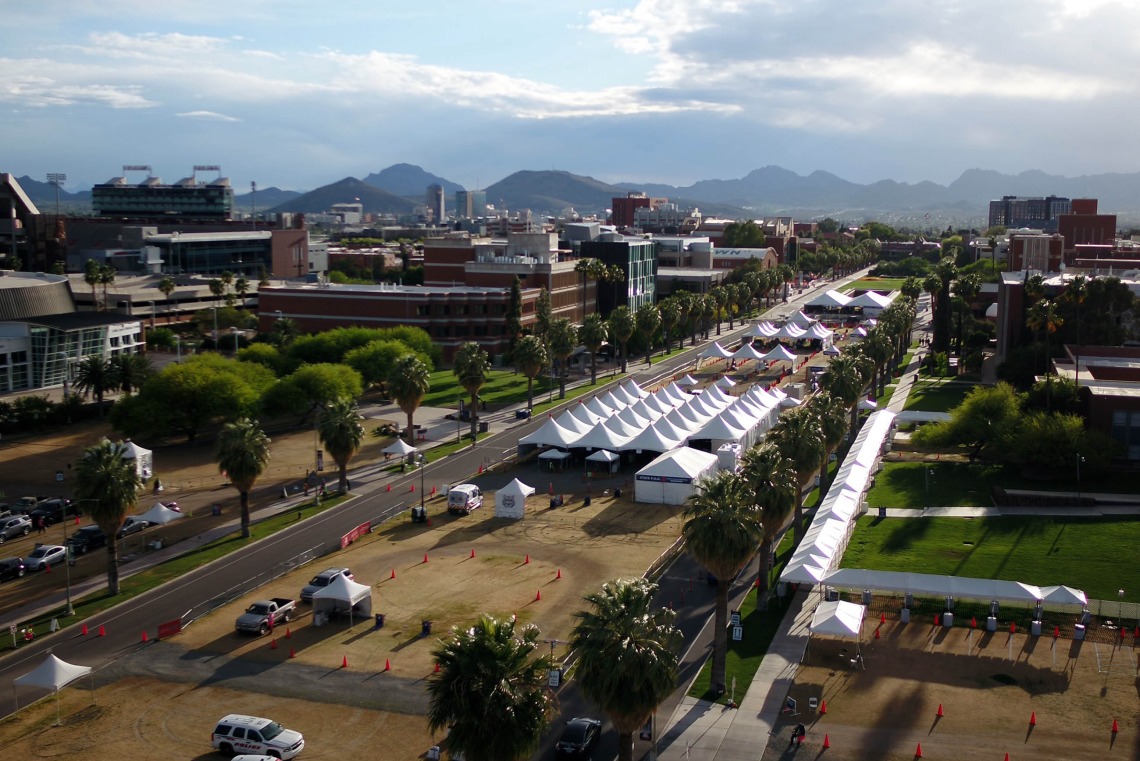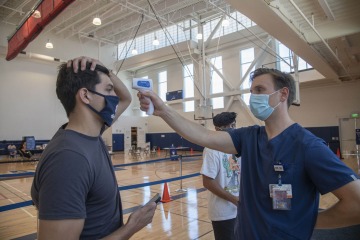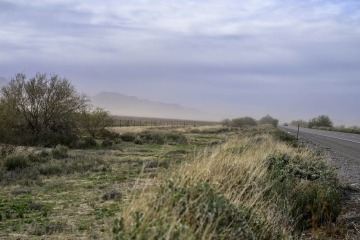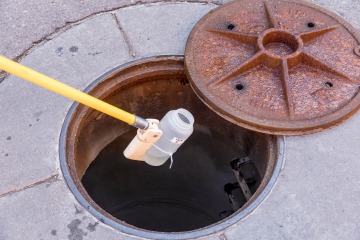5 things to know about creating a pandemic-resilient state
Janko Nikolich, MD, PhD, and the Aegis Consortium want to unite government agencies and experts in a mission to improve future pandemic responses.

The University of Arizona partnered with county and state health departments to administer more than 100,000 doses of the COVID-19 vaccine at its Point of Distribution site.
There is a popular saying that pandemics occur once every century, but in reality, the world faces widespread outbreaks of disease on a much more regular basis. These threats can come in the form of viruses, bacteria, fungi and parasites. Influenza has caused four pandemics in the last 106 years alone – in 1918, 1957, 1968 and 2009 – according to the Centers for Disease Control and Prevention.

Janko Nikolich, MD, PhD, is an internationally recognized immunologist and gerontologist. His decades of research into the immune system, infections and aging made him uniquely prepared to take on major challenges when the COVID-19 pandemic began.
Janko Nikolich, MD, PhD, director of the Aegis Consortium at the University of Arizona Health Sciences and head of the UArizona College of Medicine – Tucson’s Department of Immunobiology, has dedicated much of his career to understanding infectious diseases. During the COVID-19 pandemic, he and Deepta Bhattacharya, PhD, also a professor of immunobiology, developed one of the world’s most accurate antibody tests for SARS-CoV-2. Now, Nikolich has set his sights on a new goal: he wants to protect the planet from future pandemics.
At its peak, the COVID-19 pandemic tested the limits of health care systems, government responses, supply chains and nearly every aspect of daily life. Nikolich’s first step toward finding a global solution is to create a pandemic-resilient Arizona that can serve as a model for the rest of the nation.
Nikolich recently talked to the UArizona Health Sciences Office of Communications about what that means and how it can be achieved.
Q: What would a pandemic-resilient Arizona look like?
Nikolich: Pandemic-resilience means we would recognize a pandemic when it is at our doorstep and would have the systems in place to act to stop it. We have the opportunity now to look back on the worst days of COVID-19 and make sure we are prepared for the future in a way that we weren’t in the past. Science and technology can give us remarkable tools like vaccines and antibody tests that can be used to treat people and control outbreaks, but they can’t be effective if our society isn’t organized in a way to use them appropriately.

Before at-home COVID-19 tests became widely available, the University of Arizona partnered with local agencies to offer tests for active infections.
In a pandemic-resilient Arizona, everyone in the population would know exactly where to go to get tested and what to do if they were to fall ill. State and county health departments would be able to track where those individuals are, and a command center would be able to supply the CDC with timely updates about what is happening in Arizona. Basically, we would minimize the number of people infected and prevent as many deaths as possible. This will require collaboration with experts and decision-makers from across the state. We are inviting them to help devise strategies in crucial areas such as detection and surveillance, the health ecosystem, and climate and pandemics.
Q: What is a health ecosystem?
Nikolich: Health ecosystem is a term that broadly and inclusively describes everyone involved in health services. We’re not just talking about hospitals and doctors. This would include every health care worker and every place where folks might seek help during a public health emergency. The health ecosystem encompasses everything from nurses in clinics to social workers making home visits to assisted living facilities.

According to the Environmental Protection Agency, many regions of the U.S. can expect to see a climate-driven degradation of air quality that can cause or worsen health problems, such as respiratory and heart diseases. Environmental changes can also directly impact how pathogens are transmitted.
In a pandemic-resilient Arizona, people would be able to find out which hospital has capacity for them. Every part of the health ecosystem would know best practices on how to respond and work together. This would keep a sick person from infecting multiple other people while they are trying to find care, as well as direct a sick person where to get fastest care towards recovery.
This kind of philosophy carries over to other kinds of disaster preparation as well. You wouldn’t isolate people in the case of an earthquake or fire like you would for a pandemic, but having that coordination and planning is vital when you have a surge of people who need medical aid.
Q: How does the climate factor into pandemics?
Nikolich: Changes in the climate impact everything in the environment all the way down to microbes and how they are transmitted. We know that the dryness or wetness of the air impacts how long an airborne virus can survive. Climate and environmental changes also influence animal habitat, which can affect the spread of infectious diseases to humans.
For example, we know that West Nile virus cases regularly occur in Arizona. Thankfully, our dry weather usually keeps the mosquitoes carrying that virus inactive much of the year. But with a change in the climate, you could have more mosquitoes buzzing around for longer periods of time. Or, you could have mosquitos moving up into higher elevations, which means now they are infecting a whole new population of people.
Q: In what ways do you think detection and surveillance be improved upon in the future?
Nikolich: Many contact tracing phone apps were launched in response to the COVID-19 pandemic. I think there is a lot of potential here, in both promoting these apps to more members of the public and improving on the technology. In the future, people could use an app to see when they’ve been exposed to a virus or other contagion, and then it could give them directions on what they should do next or where they should go.

The University of Arizona was one of the first organizations to utilize wastewater testing in order to identify potential outbreaks of COVID-19. The testing proved to be an effective early-warning system for student resident halls.
Wastewater surveillance is another tool that we used and need to continuously use to give public health officials real-time information about outbreaks in an area. We also want to be able to monitor what is being transmitted in the air. We want to work with our health departments to make sure we aren’t missing anything when it comes to detection and surveillance.
Q: What is your greatest challenge moving forward?
Nikolich: We realize many people are tired of talking about COVID-19 and would love to forget about it. I think it is human nature to do that after something terrible happens, but the only way to avoid repeating history is to learn from it.
I think there is so much we can learn from the COVID-19 pandemic. Our university had a robust response and was able to integrate with government agencies as things went along, but that integration didn’t exist beforehand. I feel we all have a responsibility to build on areas of opportunity and to learn from areas where we could do better. We can make Arizona a model for the rest of the nation.
We will not be spared from the next outbreak. It is inevitable. The only question is will we be able to recognize the threat and put precautions in place to stop it from reaching global levels?
Our Experts
Janko Nikolich, MD, PhD
Professor and Head, Department of Immunobiology, College of Medicine – Tucson
Co-Director, Arizona Center on Aging, College of Medicine – Tucson
Director, AEGIS Consortium, UArizona Health Sciences
Professor, Medicine, College of Medicine – Tucson
Professor, Nutritional Sciences, College of Agriculture, Life and Environmental Sciences
Member, BIO5 Institute
Member, Cancer Biology Program, UArizona Cancer Center
Contact
Brian Brennan
University of Arizona Health Sciences Office of Communications
520-621-3510, brianbrennan@arizona.edu

